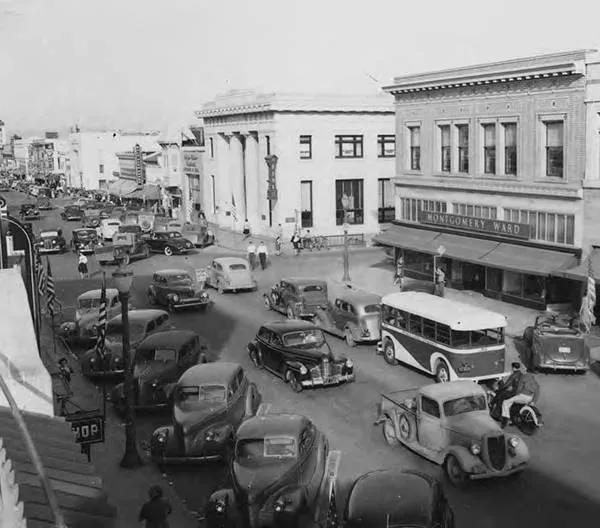This coming Sunday afternoon, the city of Palo Alto will celebrate Palo Alto Day, a commemoration of the town’s 125th anniversary since its official incorporation in 1894. The ceremony begins at 2 p.m. in King Plaza and features the reveal of a 25-year-old time capsule that was sealed in an unused elevator shaft in City Hall during the city’s centennial.
Palo Alto residents will join in on the festivities this weekend and recall some of the city’s rich history, which is intimately intertwined with that of Stanford University.
‘A true college town’
When Leland and Jane Stanford founded Stanford University in 1885, they sought to situate the budding institution in an alcohol-free “temperance town.”
Leland originally approached the nearby town of Mayfield, located around what is now College Terrace and California Avenue, and proposed to its leaders that Mayfield become the official college town of Stanford University. Mayfield, a township whose economy depended on the business of some thirteen saloons and two breweries, rejected the request due to Leland’s condition that the town ban alcohol from its premises.
“The climate [of Mayfield] was not what the Stanfords wanted to portray, not so much to the students, but to the students’ parents,” said Steve Saiger, a historian at the Palo Alto Historical Association. “They wanted a dry town and Mayfield didn’t want to be a dry town.”
So, Leland turned to his friend Timothy Hopkins, the adopted son of Central Pacific Railroad co-owner Mark Hopkins. Leland charged Hopkins with the task of erecting a new temperance town to border his university and serve as a community for the school.
“The original Palo Alto was established to be the college town for Stanford,” said Saiger. “It is the only community that was established to be a true college town.”
Palo Alto began with 740 acres of land that Hopkins purchased in 1887. The land, known as the Hopkins Tract, was bordered by Embarcadero Road, San Francisquito Creek and what are today Alma Street and Middlefield Road. This tract formed the early township, known then as University Park, and was designated as a local heritage district at Palo Alto’s centennial in 1994.
By the time classes first started at Stanford in 1891, University Park had become a bustling little village where students could spend their free time and where professors often lived. Though Stanford provided professors the option of on-campus housing, the university only allowed them to lease land; those who wanted to own property had to venture off campus.
In Stanford’s early years, most professors lived either in College Terrace, which was then still part of Mayfield, or in a small district in University Park called Professorville, so named because many university teachers resided there.
Once the town was legally incorporated under the name Palo Alto in 1894, it began to grow to the size of Mayfield as Stanford attracted students and families to the area. Eventually, in 1925, Palo Alto residents voted to annex the struggling Mayfield, which had begun banning saloons in 1905, and the two towns were consolidated later that year.
Because Palo Alto and Mayfield started as separate townships, modern Palo Alto has two downtown areas, one on University Avenue and another on California Avenue.
Growth of innovation
Another important moment in the overlapping developments of Palo Alto and Stanford occurred after World War II in the 1950s.
Stanford was in difficult financial circumstances at the war’s end, so then Provost and Dean of Engineering Frederick Terman proposed a research and development-focused business park in Palo Alto to generate money for Stanford. In 1951, Stanford Research Park was established as a joint initiative between Stanford and Palo Alto.
“When Terman came back after the war work, he said ‘We’re going to change this university. It’s not going to be a nice regional university. It’s going to be one of the best.’ Part of that was the development of the industrial park,” said Saiger.
The project benefited both the city and the university, as Stanford made money by leasing out property within the park to businesses and Palo Alto collected tax revenue since the land lies in the city’s jurisdiction.
The research park now hosts some of Silicon Valley’s most profitable and innovative companies, such as VMware Inc., SAP and Hewlett-Packard, many of which employ thousands of Palo Alto residents. In fact, seven of the top ten employers in Palo Alto last year were Stanford-affiliated or operate out of Stanford Research Park.
The Stanford Shopping Center lies in Palo Alto and was an important addition to the university because it allowed locals close access to a variety of stores.
“Before [the shopping center], if you wanted some nice clothes, you got on the train or drove to San Francisco, to Union Square,” Saiger said. “There were no regional shopping centers. This was one of the first in Northern California.”
“In some sense, [125] is an arbitrary number,” Saiger said of the anniversary to be celebrated this Sunday. However, this Palo Alto Day commemorates so much more than the city itself; it is also a celebration of the foundation of Stanford.
Contact Andrew Tan at tandrew ‘at’ stanford.edu.
